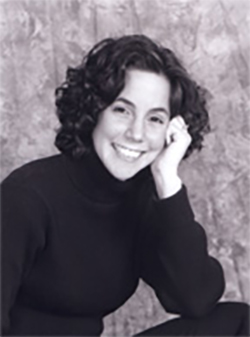Content on this webpage is provided for historical information about the NIH Clinical Center. Content is not updated after the listed publication date and may include information about programs or activities that have since been discontinued.

Knowing that you are not alone, that someone else has traveled the road you are on and lived to tell of the journey, can often be a great help to people coping with an illness.
Former Clinical Center patient Gianna Pedace Allentuck understands this. In 1996, at the age of 25, she was diagnosed with non-Hodgkin’s lymphoma, and underwent chemotherapy at the Clinical Center as a participant in an NCI clinical trial.
“While I survived the rigors of chemotherapy and continue to remain in remission, I firmly believe I would not have fared so well without the constant love and support provided by my family and friends,” she said.
“Unfortunately, however, there are those who do not have a support system equal to my own; and who do not survive their own battles with chemotherapy so well, sometimes succumbing to the cancer.”
As a tribute to family, friends, and fellow patients, and in an effort to reach out to other families coping with serious illness, Allentuck has written a book of essays, “Welcome to My Heart,” detailing various experiences during diagnosis and treatment of her disease.
In addition to providing emotional support for patients and their families, Allentuck wants the book to benefit others in a very concrete way.
She plans to donate all proceeds from the sale of her book to The Children’s Inn at NIH. “Our goal is to sell 3,000 books and raise a significant amount for the Inn,” she said. “I believe strongly in the loving, supportive atmosphere fostered by the Inn, and I hope this book will be of help to children and their families during such a frightening time.”
The following excerpt is from her essay entitled “The World Series”: I had expected the NIH Clinical Center to be a sterile, serious place with doctors and nurses stiffly walking from room to room and patient to patient.
Instead, I had been greeted with smiles and laughter. While the goals of the clinic remain serious, the staff are also serious about making the patients feel at ease, feel better, which is a huge step in the scary road to treatment and hopefully recovery.
NIH is one big major league with all the different departments acting as teams. I would become a player for the clinical team (the Yankees, let’s say); and when we all worked/played together, my treatment game plan played out like the 1998 World Series.
I had been scheduled for several tests that day, and each department we visited, from Phlebotomy to Radiology to the 10th floor nurses station to the 12th floor Clinic, pulled together as a team to make my appointments as comfortable as possible. The nurses who draw blood in Phlebotomy, conscious of my nervousness about giving blood, distracted me by playfully teasing each other about who was the best “draw” nurse. One nurse in particular, named “the cat man” because he has so many cats, drew a picture of a kitty cat on my arm bandage after I told him about my two kittens, Bob and Chunky. While the bandage only stayed with me for about 15 minutes, the cat man’s sensitivity and sense of humor have stayed with me since then.
The staff of the Radiology Department were also sensitive to my nerves and my needs. When I went for my X-rays, CT scans, and “glow-in-the-dark” test, the nurses and technicians always offered me a heated blanket.
Usually I was shaking from both anxiety and cold, and the cozy blanket always warmed my limbs and settled my nerves.... After Lee and I finished making the scheduled rounds, we returned to the 10th floor nurses station.... After thanking the doctors and Deb for their time, I asked for a moment alone with Lee so that we could discuss my entering the clinical trial versus undergoing standard treatments with Georgetown or a private clinic. Once the doctors had left the room, Lee and I reviewed the paperwork and the information that the doctors had given us and decided to sign up for the program. We felt that after dealing with the wonderful staff of NIH all day and finally ending up with obviously caring and intelligent doctors, in addition to the convenience of NIH, it would be best to join the protocol.
I had been a “free-agent” weighing my treatment options, and I decided to sign with this team of superstars. A decision that has clearly paid off as we continue to hit home runs together each time I leave the clinic with another quarterly clean bill of health. For me, NIH has never been about individual status or priorities, but about teamwork. About working together to reach the ultimate goal — patient recovery — the victory in life’s world series.

